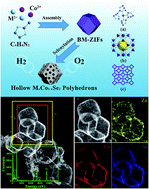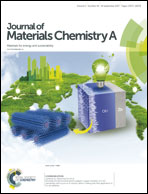Hollow bimetallic cobalt-based selenide polyhedrons derived from metal–organic framework: an efficient bifunctional electrocatalyst for overall water splitting†
Abstract
The development of highly active, stable and affordable hydrogen evolution reaction (HER) and oxygen evolution reaction (OER) electrocatalysts for renewable energy reserve and conversion remains a serious challenge. In this study, a simple solvothermal strategy is adopted to synthesize hollow bimetallic cobalt-based selenide templated by cobalt-based bimetallic organic frameworks (BM-ZIFs) with superior water splitting activity and stability, owing to the perfect hollow polyhedral structure with numerous active sites. Moreover, the introduction of a transition metal element not only enhances the electroconductibility of the catalyst, but also further improves the electrocatalytic ability via the Jahn–Teller effect. Furthermore, the synthetic method is convenient and low toxic without high temperature carbonization process. The as-synthesized hollow MxCo1−xSe2 polyhedrons exhibit excellent electrocatalytic performances. Particularly, the Zn0.1Co0.9Se2 exhibits low overpotentials of −140 mV and 340 mV at a current density of 10 mA cm−2, a small Tafel slope of 49.9 mV dec−1 and 43.2 mV dec−1 as well as a high current density with robust catalytic stability for both HER in acidic and OER in basic solutions, respectively. This strategy provides a prospect for preparation of homogenously doped and self-templated hollow structure non-noble metal electrocatalysts with high HER and OER performance.



 Please wait while we load your content...
Please wait while we load your content...